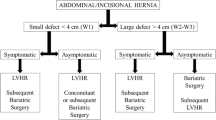Abstract
Introduction
Incisional and ventral hernias are common surgical indications. Their management is associated with significant complications and recurrences in open surgery (15–25 %). Since laparoscopy has become a standard in bariatric surgery, there has been a natural trend to treat obese patients with parietal wall defects laparoscopically. The aim of our study was to evaluate the feasibility and the results of the laparoscopic management of parietal wall defects in patients with a BMI >35.
Materials and methods
A series of 79 patients were included. Data were acquired prospectively and analyzed retrospectively. The surgical procedure was standardized: 3 ports, mesh type (Parietex™ Composite mesh, Covidien, France), fixation with non-absorbable transfascial sutures, and tackers. Complications were evaluated.
Results
Out of 79 patients (29 men, 50 women), 43 had umbilical and 36 had ventral hernias. Mean age was 52.4 years, and mean BMI was 40.83 kg/m2. Mean postoperative hospital stay was 2 days. Postoperative pain evaluated by visual analog scale was 2.86. No intraoperative complications or deaths occurred. Seven postoperative complications occurred (8.86 %): two parietal wall hematomas treated by radiological embolization, two significant cases of postoperative pain, one postoperative obstruction, one spontaneously resolved respiratory failure, and one early (day 1) parietal wall defect with immediate reoperation. Postoperative seroma rate was 26.58 % (21 patients, all of whom were treated conservatively). Postoperative follow-up was 18.10 months (1–84 months), and recurrence rate was 3.8 % (3 patients).
Discussion
This study confirms the feasibility and safety of the laparoscopic approach for ventral hernias in morbidly obese patients. Recurrence rates (3.8 %) appeared lower than the ones observed in the literature (15–25 %). Postoperative hemorrhage and port-site hernia are specific complications of this approach. Postoperative hospital stay is low (2 days) as compared to open surgery. Laparoscopic management of parietal wall defects should be considered a standard option in morbidly obese patients.
Similar content being viewed by others
References
Colon MJ, Kitamura R, Telem DA, Nguyen S, Divino CM (2013) Laparoscopic umbilical hernia repair is the preferred approach in obese patients. Am J Surg 205:231–236
Reynvoet E, Deschepper E, Rogiers X, Troisi R, Berrevoet F (2013) Laparoscopic ventral hernia repair: is there an optimal mesh fixation technique? A systematic review. Langenbecks Arch Surg. 399(1):55–63
Tsereteli Z, Pryor BA, Heniford BT, Park A, Voeller G, Ramshaw BJ (2008) Laparoscopic ventral hernia repair (LVHR) in morbidly obese patients. Hernia 12:233–238
Birgisson G, Park AE, Mastrangelo MJ Jr, Witzke DB, Chu UB (2001) Obesity and laparoscopic repair of ventral hernias. Surg Endosc 15:1419–1422
Pierce RA, Spitler JA, Frisella MM, Matthews BD, Brunt LM (2007) Pooled data analysis of laparoscopic versus open ventral hernia repair: 14 years of patient data accrual. Surg Endosc 21:378–386
Novitsky YW, Cobb WS, Kercher KW, Matthews BD, Sing RF, Heniford BT (2006) Laparoscopic ventral hernia repair in obese patients: a new standard of care. Arch Surg 141:57–61
Heniford BT, Park A, Ramshaw BJ, Voeller G (2003) Laparoscopic repair of ventral hernias: nine years’ experience with 850 consecutive hernias. Ann Surg 238:391–399; discussion 399–400
Ching SS, Sarela AI, Dexter SP, Hayden JD, McMahon MJ (2008) Comparison of early outcomes for laparoscopic ventral hernia repair between nonobese and morbidly obese patient populations. Surg Endosc 22:2244–2250
Alexander AM, Scott DJ (2013) Laparoscopic ventral hernia repair. Surg Clin North Am 93:1091–1110
Kaoutzanis C, Leichtle SW, Mouawad NJ, Welch KB, Lampman RM, Cleary RK (2013) Postoperative surgical site infections after ventral/incisional hernia repair: a comparison of open and laparoscopic outcomes. Surg Endosc 27:2221–2230
Colavita PD, Tsirline VB, Belyansky I, Walters AL, Lincourt AE, Sing RF, Heniford BT (2012) Prospective, long-term comparison of quality of life in laparoscopic versus open ventral hernia repair. Ann Surg 256:714–722
Mc Kinlay RD, Park A (2004) Laparoscopic ventral incisional hernia repair: a more effective alternative to conventional repair of recurrent incisional hernia. J Gastrointest Surg 8:670–673
Polavarapu HV, Kurian AA, Josloff R (2012) Laparoscopic ventral hernia repair in the elderly: does the type of hernia matter? Hernia 16:425–429
LeBlanc KA, Booth WV (1993) Laparoscopic repair of incisional abdominal hernias using expanded polytetrafluoroethylene: preliminary findings. Surg Laparosc Endosc 3:39–41
Acknowledgments
The authors are grateful to Guy Temporal and Christopher Burel for their proofreading assistance.
Disclosure
Professor D Mutter and Doctors L Marx, M Raharimanantsoa, S Mandala, A D’Urso, M Vix declare no financial conflicts of interest or conflicts of any other type in relation to the content of this article.
Author information
Authors and Affiliations
Corresponding author
Rights and permissions
About this article
Cite this article
Marx, L., Raharimanantsoa, M., Mandala, S. et al. Laparoscopic treatment of incisional and primary ventral hernia in morbidly obese patients with a BMI over 35. Surg Endosc 28, 3310–3314 (2014). https://doi.org/10.1007/s00464-014-3607-6
Received:
Accepted:
Published:
Issue Date:
DOI: https://doi.org/10.1007/s00464-014-3607-6




